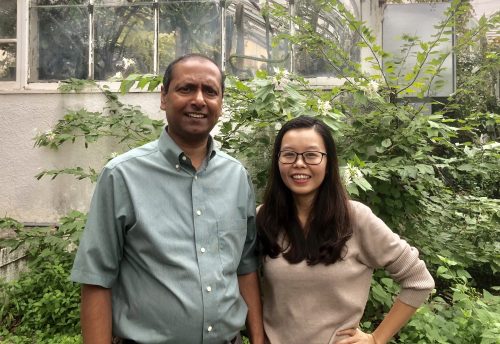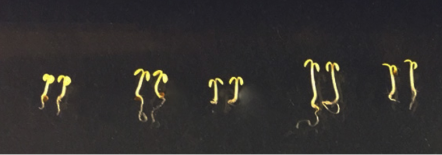The people behind the papers – Vinh Ngoc Pham and Enamul Huq
Posted by the Node Interviews, on 16 January 2019
This interview, the 53rd in our series, was published in Development last year
The ability to sense and respond to light is fundamental to plant development. As seedlings move from the soil to the air, a switch in developmental program occurs to promote light capture and autotrophic growth. A paper in Development now provides a molecular analysis of the proteins that regulate this transition in Arabidopsis. We caught up with first author and PhD student Vinh Ngoc Pham, and her supervisor Enamul Huq, Professor of Molecular Biosciences at The University of Texas at Austin, to find out more about the work.

Enamul, can you give us your scientific biography and the questions your lab is trying to answer?
EH I received BSc and MSc degrees in Biochemistry from the University of Dhaka, Bangladesh, in 1987 and 1988, respectively. As a graduate student in Thomas Hodges’ lab in Purdue University I worked on characterizing hypoxia-inducible gene expression in rice. I then did my post-doctoral research with Peter Quail at UC Berkeley, where I isolated and characterized phytochrome interacting factors (PIFs) in Arabidopsis.
I began my academic career as an Assistant Professor of Molecular Cell and Developmental Biology at The University of Texas at Austin in 2003, and am now a Professor of Molecular Biosciences. Research in my lab is focused on understanding how plants sense, interpret and respond to environmental light conditions that regulate almost every aspect of the life cycle, from seed germination to flowering time. Specifically, we focus on the red/far-red light photoreceptors (phytochromes) and their interacting PIFs.
And Vinh, how did you come to join the Huq lab and what drives your research?
VNP I have been fascinated by plants and how they respond to light signals since I was an undergraduate student. I did a student internship at POSTECH University in South Korea, working on PIFs. I decided to pursue my Master’s degree in POSTECH, and that was a great opportunity for me to learn the biology of light signalling. I first met Enamul during the International Plant Molecular Biology Conference in South Korea in 2012, and was interested in his research about PIF regulation. Being a Fellow of the Vietnam Education Foundation (VEF), an educational exchange program between Vietnam and the USA for PhD programs, I decided to apply to Enamul’s lab to continue my research in the light-signalling field.
What makes skoto-to-photomorophogenesis such a crucial developmental transition in a plant’s life?
VNP & EH Germinating seeds and young seedlings are very vulnerable, just like human babies at young ages. A proper transition from the dark-adapted developmental program called skotomorphogenesis to the light-adapted developmental program called photomorphogenesis is crucial for their survival. Skotomorphogenesis is defined by seedlings having long hypocotyls, appressed small cotyledons and an apical hook. This morphological pattern ensures the safe emergence of the seedlings, protecting their apical region in the subterranean darkness. Conversely, photomorphogenesis is defined by seedlings having short hypocotyls and open, expanded and green cotyledons that help plants capture maximum sunlight for photosynthetic energy production and autotrophic growth. Scientists have been using this transition to study light-signalling pathways for decades, and have isolated many mutants that mimic light-grown plants when grown in darkness. These are called constitutive photomorphogenic (cop) mutants, and have tremendously helped decipher mechanisms of light-signalling pathways.
Can you give us the key results of the paper in a paragraph?
VNP & EH In this paper, we provide multiple lines of evidence to explain why the cop1, spaQ and pifQ mutants display constitutive photomorphogenic phenotypes. Previously, it was shown that the so-called positively acting transcription factors were more abundant in cop1, spaQ and pifQ mutants compared with wild type, resulting in the cop phenotype. However, we now show that the cop phenotypes are not only due to a high abundance of the positively acting transcription factors, but also due to a reduced level of PIF protein levels. In addition, a high abundance of HFR1 in the cop1 and spamutants also reduces PIFs transcriptional activity. Strikingly, the gene expression signature of cop1 and spaQ overlaps with pifQ in the dark, with a preferential targeting of PIF direct target genes. All three activities are tightly linked to each other, contributing in concert to the cop phenotypes.
How do you think the COP1/SPA complex regulates PIF abundance and activity?
VNP & EH We think that the COP1/SPA complex regulates PIF abundance in both dark and light conditions. In the dark, HFR1, an atypical bHLH factor, is more abundant in the cop1 and spaQ mutants compared with wild type. HFR1 heterodimerizes with PIFs and induces degradation of this heterodimer through the COP1/SPA complex in darkness. In addition, HFR1 also sequesters PIFs from binding to DNA, thereby inhibiting PIF activity in darkness. In response to light, PIFs are phosphorylated in a phytochrome interaction-dependent manner. The phosphorylated forms of PIFs are then recruited by the COP1/SPA complex in a CUL4COP1-SPA E3 Ubiquitin ligase complex for ubiquitylation and rapid degradation through the 26S proteasome pathway.

When doing the research, did you have any particular result or eureka moment that has stuck with you?
VNP In our lab, we do a lot of biochemistry and molecular genetics. At the beginning, I spent a lot of time studying genomic data analysis and enjoyed applying genomic data to the big picture of plant light-signalling pathways. Therefore, applying transcriptomic and gene expression tools in cop1, spaQ and pifQ mutants in this paper gave us an integrated view of how gene expression is regulated in light-signalling pathways. The interesting part of this paper was when we analysed the RNA-Seq data and figured out that more than 40% of PIF-regulated genes are significantly regulated by COP1 and SPA. After that we became more confident about our hypothesis of the cop phenotypes due to the regulation of PIF level and PIF transcriptional activity.
And what about the flipside: any moments of frustration or despair?
VNP I became frustrated many times working on the PIF degradation experiments. PIFs are degraded very quickly in the light so we have to do all the PIF protein experiments in the dark. That was not easy at the beginning but when I got used to it, I really enjoyed doing experiments in the dark room. It also gave me a chance to take an occasional nap!
It took us a very long time to generate the PIF5 overexpression line in the spaQ background, as this is a quadruple mutant and a tiny plant. spaQ mutants do not make a lot of seeds for the next generation, so we spent a lot of time genotyping and waiting for enough seeds to do all of our assays.
So what next for you after this paper?
VNP I am very excited about applying computational biology methods to study regulatory gene networks in light-signalling pathways. I hope this will be a great resource for other researchers and will provide a holistic view of the transcriptional regulatory mechanisms in Arabidopsis light-signalling pathways. After this project, I would like to find a postdoctoral position where I can apply and develop both my molecular genetics skills and computational biology to understand biological networks.
Where will this work take the Huq lab?
EH We are still focusing on the intersection between the COP1/SPA complex and PIFs. A simple Pubmed search on ‘COP1’ resulted in over 550 papers – including many from us – published in the last few years, and we really think they hold the key to light-signalling pathways in plants. On a molecular level, SPA proteins have kinase-like domains at their N terminus, but a kinase activity has not been demonstrated yet. If SPAs do function as protein kinases, the COP1/SPA complex might function as a unique cognate kinase-E3 Ubiquitin ligase complex for rapid phosphorylation and degradation of their substrates. There is so much more to be learned about these complexes and their biochemical functions in regulating plant development.
There is so much more to be learned about these complexes and their biochemical functions in regulating plant development
Finally, let’s move outside the lab – what do you like to do when you’re not working?
EH Austin is a lovely city. We really enjoy hiking and exploring the trails and parks nearby. In addition, Austin is the music capital of the world as well as a kind of second Silicon Valley with many high-tech companies established here. With increasing international population on campus as well as around the city, Austin has a variety of great food and culture throughout the year.
VNP When I have free time, I try to cook great food, and I think I am a good pastry chef too. I think doing science is like cooking, following new recipes (protocols) to come up with interesting new outcomes!


 (No Ratings Yet)
(No Ratings Yet)